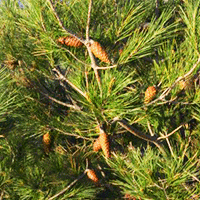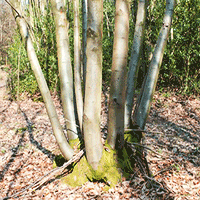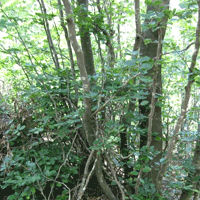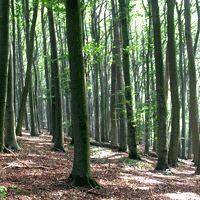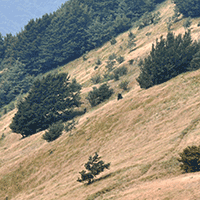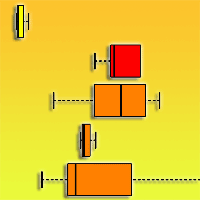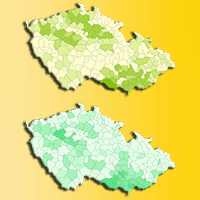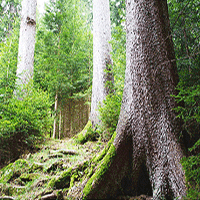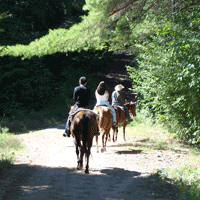
Opportunities for coppice management at the landscape level: the Italian experience
Paola Mairota (1) , Maria Chiara Manetti (2), Emilio Amorini (2), Francesco Pelleri (2), Marco Terradura (3), Mauro Frattegiani (3), Paola Savini (3), Francesco Grohmann (4), Paolo Mori (5), Pier Giorgio Terzuolo (6), Pietro Piussi (7)
iForest - Biogeosciences and Forestry, Volume 9, Issue 5, Pages 775-782 (2016)
doi: https://doi.org/10.3832/ifor1865-009
Published: Aug 04, 2016 - Copyright © 2016 SISEF
Review Papers
Collection/Special Issue: IUFRO division 8.02 - Mendel University Brno (Czech Republic) 2015
Coppice forests: past, present and future
Guest Editors: Tomas Vrska, Renzo Motta, Alex Mosseler
Abstract
Coppice silviculture has a long tradition in Italy. Societal demands have led to the development of forest management techniques for integrating wood production with other kinds of forest uses and regulations have been issued to limit forest degradation. In Italy, 35% of the national forest cover is currently managed under coppice silvicultural systems that provide 66% of the annual wood production. Fuel-wood demand is increasing and a large amount of fuel-wood is currently imported in Italy. Modern coppice practices differ from those adopted in the past and may have a reduced impact on ecosystem characteristics and processes. Nevertheless, coppice silviculture has a bad reputation mostly on grounds that are beyond economic, technical and ecological rationales. Neither cessation of use nor a generalized conversion from coppice to high forest are likely to respond simultaneously to the many demands deriving from complex and articulated political and economic perspectives operating at global, European, national, regional and forest stand-level scales. Different approaches of modern silviculture to coppice successfully tested in Italy for more than a decade are illustrated. We propose to combine different options at the stand and sub-stand level, including either development without human interference or conversion to high forest, and to apply these approaches within the framework of novel forest management plans and regionally consistent administrative procedures. This bottom-up approach represents a potential solution to the socio-economic and environmental challenges affecting coppicing as a silvicultural system.
Keywords
Biodiversity, Coppice Silviculture, Environmental Change, Landscape, Socio-economic Dynamics, Sustainable Forest Management
Authors’ Info
Authors’ address
DiSAAT, University of Bari “Aldo Moro”, v. Orabona 4, I-70125 Bari (Italy)
Emilio Amorini
Francesco Pelleri
Consiglio per la Ricerca e la sperimentazione in Agricoltura - Forestry Research Centre, v.le Santa Margherita 80, I-52100 Arezzo (Italy)
Mauro Frattegiani
Paola Savini
Arborea coworking, v. A. Diaz 5/7, I-06128 Perugia (Italy)
Servizio Foreste, economia e territorio montano, Regione Umbria, v. M. Angeloni 61, I-06124 Perugia (Italy)
Compagnia delle Foreste, v. Pietro Aretino 8, I-52100 Arezzo (Italy)
Institute for Timber Plants and the Environment (IPLA), c.so Casale 476, Torino (Italy)
University of Florence, v. San Bonaventura 13, I-50145 Firenze (Italy)
Corresponding author
Paper Info
Citation
Mairota P, Manetti MC, Amorini E, Pelleri F, Terradura M, Frattegiani M, Savini P, Grohmann F, Mori P, Terzuolo PG, Piussi P (2016). Opportunities for coppice management at the landscape level: the Italian experience. iForest 9: 775-782. - doi: 10.3832/ifor1865-009
Academic Editor
Tomas Vrska
Paper history
Received: Sep 08, 2015
Accepted: May 26, 2016
First online: Aug 04, 2016
Publication Date: Oct 13, 2016
Publication Time: 2.33 months
Copyright Information
© SISEF - The Italian Society of Silviculture and Forest Ecology 2016
Open Access
This article is distributed under the terms of the Creative Commons Attribution-Non Commercial 4.0 International (https://creativecommons.org/licenses/by-nc/4.0/), which permits unrestricted use, distribution, and reproduction in any medium, provided you give appropriate credit to the original author(s) and the source, provide a link to the Creative Commons license, and indicate if changes were made.
Web Metrics
Breakdown by View Type
Article Usage
Total Article Views: 55863
(from publication date up to now)
Breakdown by View Type
HTML Page Views: 45162
Abstract Page Views: 4342
PDF Downloads: 4556
Citation/Reference Downloads: 58
XML Downloads: 1745
Web Metrics
Days since publication: 3441
Overall contacts: 55863
Avg. contacts per week: 113.64
Citation Metrics
Article Citations
Article citations are based on data periodically collected from the Clarivate Web of Science web site
(last update: Mar 2025)
Total number of cites (since 2016): 17
Average cites per year: 1.70
Publication Metrics
by Dimensions ©
Articles citing this article
List of the papers citing this article based on CrossRef Cited-by.
References
I boschi di origine cedua nella selvicoltura italiana: sperimentazione, ricerca, prassi operativa [Coppice woodlands in Italian silviculture: experiences, research, operations]. In: Proceedings of the “III National Silviculture Congress”. Taormina (Messina, Italy) 16-18 Oct 2008. Accademia Italiana di Scienze Forestali, Firenze, Italy, vol. II, pp. 201-207. [in Italian]
Gscholar
La matricinatura nei cedui di cerro: indagine in provincia di Perugia [Standards’ retention in Turkey oak woodlands: survey in the Perugia province] Sherwood - Foreste e alberi oggi 34: 21-27. [in Italian]
Gscholar
Selvicoltura produttiva. Manuale pratico [Production silviculture. A practical handbook]. Edagricole, Bologna, Italy, pp. 225. [in Italian]
Gscholar
Options forestry - acting on uncertainty. Journal of Forestry 102: 22-27.
Gscholar
The flora and fauna of coppice woods: winners and losers of active management or neglect? In: “Europe’s Changing Woods and Forests: From Wildwood to Managed Landscapes” (Kirby K, Watkins C eds). CABI, Wallingford, UK, pp. 129-139.
Gscholar
Come nasce una foresta modello [How a model forest is born. The Tuscan experience] Sherwood - Foreste e alberi oggi 171: 13-16. [in Italian]
Gscholar
Socio-ecological system of coppiced forests in the Italian Marche Region’s central Apennine. PhD Thesis, School of Advanced Studies, University of Camerino, Camerino, Italy, pp. 98.
Gscholar
Il ceduo come opera di sistemazione idraulica: la stabilità dei cedui invecchiati [Coppice as an hydraulic management work: over-grown coppices stability]. In: Proceedings of the “46° Course on Culture in Ecology” (Carraro V, Anfodillo T eds). San Vito di Cadore (Belluno, Italy) 7-10 Jun 2010, University of Padua, Padua, Italy, pp. 85-96.
Gscholar
Gestione forestale e produzione legnosa a fini energetici [Forest management and energy wood production]. Sherwood - Foreste e alberi oggi 59: 5-9. [in Italian]
Gscholar
Il ceduo tra passato e attualità: opzioni colturali e dinamica dendro-auxonomica e strutturale nei boschi di origine cedua [Coppice between past and present: coltural options and dendro-auxonomic and structural dynamics in coppice woodlands]. In: Proceedings of the “46° Course on Culture in Ecology” (Carraro V, Anfodillo T eds). San Vito di Cadore (Belluno, Italy) 7-10 Jun 2010, University of Padua, Padua, Italy, pp. 27-45. [in Italian]
Gscholar
Forest planning and sporadic species LIFE+ PProSpoT project: first experience in Italy. Sherwood - Foreste e alberi oggi 184: 9-14.
Gscholar
La filiera legno-energia locale fa bene all’economia e al clima [Short wood-energy supply chain benefit both economy and environment]. Agriforenergy 3: 30-32. [in Italian]
Gscholar
Scales and diversity responses to management in Beech coppices of central Apennines (Marche, Italy): from floristic relevés to functional groups. Braun-Blanquetia 46: 271-278.
Gscholar
An ecological aesthetic for forest landscape management. Landscape Journal 18: 54-64.
Gscholar
Introduction à la gestion forestière en Ombrie et présentation des activités de la Région Ombrie dans le project RECOFORME [Introduction to forest management in Umbria and presentation of the activities of the Umbria Region within the framework of the RECOFORME Project]. Association Internationale Forêts Méditerranéennes, Cahier de site 5, Marseille, France, pp. 20-22. [in French]
Gscholar
Les méthods de l’aménagement forestier en France [The methods of forest management in France]. Annales de l’École Nationale des Eaux et Forêts et de la Station de Recherches et Expériences I, Berger-Levrault, Paris, France, pp. 229. [in French]
Gscholar
Le stime di superficie 2005 - Prima parte” Authors: Tabacchi G, De Natale F, Di Cosmo L, Floris A, Gagliano C, Gasparini P, Genchi L, Scrinzi G, Tosi V. Inventario Nazionale delle Foreste e dei Serbatoi Forestali di Carbonio [National Inventory of Forests and of Forest Carbon Pools]. MiPAF - Corpo Forestale dello Stato - Ispettorato Generale, CRA - ISAFA, Trento, Italy, pp 409. [in Italian]
Online | Gscholar
Creating a forestry for the 21st century: the science of ecosystem management. Island Press, Washington, DC, USA, pp. 479.
Gscholar
Il ceduo in Italia aspetti colturali, produttivi, ambientali [Coppice woodlands in Italy, coltural, production and environmental aspects]. Sherwood - Foreste e alberi oggi 173: 5-14. [in Italian]
Gscholar
Gestione del bosco e conservazione della biodiversità: l’analisi eco-paesistica applicata a territori boscati della Toscana meridionale [Forest management and biodiversity conservation: landscape ecological analysis of wooded lands in southern Tuscany]. In: “Selvicoltura sostenibile nei boschi cedui” [Sustainable silviculture in coppice woodlands] (Fabbio G ed). Annali C.R.A. - Istituto Sperimentale per la Selvicoltura 33: 187-230. [in Italian]
Gscholar
Ecosistemi forestali nel paesaggio [Forest ecosystems in the landscape]. In: Proceedings of the “III National Silviculture Congress”. Taormina (Messina, Italy) 16-18 Oct 2008. Accademia Italiana di Scienze Forestali, Firenze, Italy, vol. III, pp. 995-1000. [in Italian]
Gscholar
New silvicultural models to improve functionality of chestnut stands. Advances in Horticultural Science 1: 65-69.
Gscholar
Ecosystems and human well-being. Island Press, Washington, DC, USA, pp. 917.
Gscholar
When beech strikes back: How strict nature conservation reduces herb-layer diversity and productivity in Central European deciduous forests Forest Ecology and Management 319: 51-61.
Gscholar
Il governo misto [Mixed management]. Sherwood - Foreste e alberi oggi 211: 5-9. [in Italian]
Gscholar
Silviculture: concept and applications (2nd edn). McGraw-Hill, New York, USA, pp. 682.
Gscholar
Environmentally sound harvesting technologies in commercial forests in the area of Northern Velebit-Functional terrain classification. Periodicum biologorum 110: 127-135.
Gscholar
Economia forestale - Trattamento dei boschi [Forest economy - Forest treatment]. Vallardi, Milano, Italy, pp. 167. [in Italian]
Gscholar
Silviculture [Sylviculture]. École Nationale des Eaux et Forets, Nancy, France, pp. 411. [in French]
Gscholar
Le traitement en taillis de certaines forêts de la Toscane du XVIème au XXème siècle [Coppice treatment of certain forests of Tuscany during the XVI and XX centuries]. Actes du Symposium International d’Histoire Forestiere. Nancy (France) 24-28 Sep 1979. ENGREF 1: 50-57.
Gscholar
Storia agraria e selvicoltura [Agrarian history and silviculture]. In: “Medievistica Italiana e Storia Agraria” (Cortonesi A, Montanari M eds) CLUEB, Bologna, Italy, pp. 179-209. [in Italian]
Gscholar
Considerazioni sul governo a ceduo composto in Toscana [Considerations on the compound coppice silvicultural system in Tuscany]. Sherwood - Foreste e alberi oggi 131: 5-12. [in Italian]
Gscholar
Cosa non funziona nella difesa dal rischio idro-geologico nel nostro paese? Analisi e rimedi [What’s wrong in the control of the hydro-geological risk in our country? Analysis and remedies]. In: Proceedings of the “Convegni Lincei”. Accademia Nazionale dei Lincei, Scienze e Lettere Editore Commerciale, Roma, Italy, 270: 137-150. [in Italian]
Gscholar
Selvicoltura generale. Boschi, società e tecniche colturali [Silviculture. Forests, societies, and coltural techniques]. Compagnia delle Foreste, Arezzo, Italy, pp. 432. [in Italian]
Gscholar
Tree-oriented silviculture in young coppices. Silvicultural practices to enhance sporadic species: the LIFE+ PPRoSpoT project experience. Sherwood - foreste e alberi oggi 185: 5-10.
Gscholar
Nuove tecniche di intervento nei boschi cedui [New intervention techniques in coppice woodlands]. In: Proceedings of the “46° Course on Culture in Ecology” (Carraro V, Anfodillo T eds). San Vito di Cadore (Belluno, Italy) 7-10 Jun 2010. University of Padua, Padua, Italy, pp. 73-84. [in Italian]
Gscholar
Studio sulla produzione cedua forestale Toscana [Essay on coppice production of Tuscany]. Ramella Edizioni, Firenze, Italy, pp. 140. [in Italian]
Gscholar
Metodo dei lotti. Assestamento delle specie sporadiche in grado di produrre assortimenti di pregio [Method of lots. Management of sporadic tree species for the production of valuable assortments]. Sherwood - Foreste e alberi oggi 174: 45-50. [in Italian]
Gscholar
Il faggio: Conoscenze e indirizzi per la gestione sostenibile in Piemonte [Beech: knolwedge and sustainable management options in Piemonte]. Regione Piemonte, Blu Edizioni, pp. 136. [in Italian]
Gscholar
Forest resources of Europe, CIS, North America, Australia, Japan and New Zealand (TBFRA-2000). ECE/TIM/SP/17, Geneva, Switzerland, pp. 466.
Gscholar
Management driven changes (1967-2005) in soil acidity and the understorey plant community following conversion of a coppice-with-standards forest. Forest Ecology and Management 241: 258-271.
CrossRef | Gscholar
The agri-environment. Cambridge University Press, Cambridge, UK, pp. 224.
Gscholar

